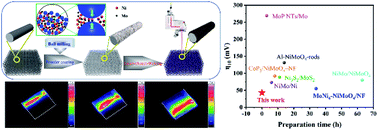A smart strategy of “laser-direct-writing” to achieve scalable fabrication of self-supported MoNi4/Ni catalysts for efficient and durable hydrogen evolution reaction†
Abstract
Water electrolysis is the major prerequisite to realizing future global carbon neutrality, and large-scale production of efficient and economic electrocatalysts is essential for industrial hydrogen production. Herein, MoNi4 catalysts were synthesized by a two-step approach of ball milling and laser-direct-writing, where Ni–Mo powders were directly converted into a MoNi4 alloyed compound and strongly anchored on a nickel foam matrix. The MoNi4/Ni catalyst achieved an overpotential of 43 mV at a current density of 10 mA cm−2 in 1 M KOH, along with impressive stability at a large current density of 400 mA cm−2 for 100 h. The overpotential of MoNi4/Ni also showed 198 mV lower than that of a commercial Ni mesh electrode when evaluated under real industrial conditions (6 M KOH at 70 °C), allowing its feasibility for practical utilization. Commercial silicon solar cell-driven water electrolysis based on MoNi4 catalysts was also demonstrated, suggesting a promising alternative for replacing noble catalysts for sustainable energy generation.



 Please wait while we load your content...
Please wait while we load your content...